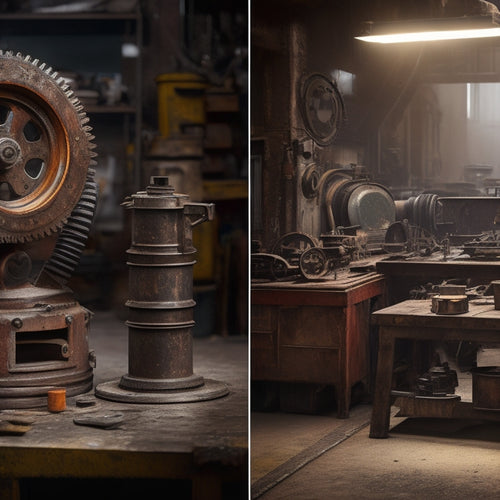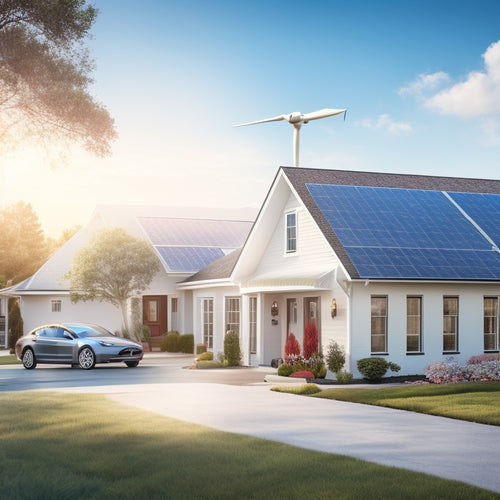
5 Key Considerations for Photovoltaic Solar Panels Cost
Share
When calculating the cost of photovoltaic solar panels, you'll want to evaluate system size and output, as a larger system doesn't always mean more energy. You'll need to balance system size with efficiency to maximize energy output. Labor costs, permitting fees, and installation complexity also impact your total cost. Additionally, the quality and durability of your panels, as well as inverter and mounting options, will influence your overall expense. Finally, local incentives and rebates can considerably reduce your costs. By understanding these key factors, you'll be able to make an informed decision and optimize your investment in clean energy - and that's just the beginning of your solar expedition.
Key Takeaways
- System size and efficiency must be balanced to maximize energy output and minimize costs, considering energy needs and available roof space.
- Installation and labor costs vary based on system size, complexity, and local regulations, and can be optimized with financing options.
- High-quality panels from reputable manufacturers ensure longevity, performance, and warranty coverage, reducing risk and maintenance costs.
- Inverter and mounting options impact energy output, maintenance, and aesthetics, with high-efficiency choices maximizing return on investment.
- Local incentives, rebates, and financing options can significantly reduce upfront costs and optimize return on investment for photovoltaic solar panels.
System Size and Output
A typical residential photovoltaic (PV) system ranges from 2 to 10 kilowatts (kW) in size, with the average system hovering around 5-7 kW. As you consider installing a PV system, it's crucial to understand how system size affects energy production and overall cost.
A larger system doesn't always mean more energy production. System efficiency, which is the percentage of sunlight converted into electricity, plays a significant role. A more efficient system can produce more energy with fewer panels, reducing the overall cost.
You'll want to balance system size with efficiency to maximize your energy output. When evaluating system size and output, you should consider your energy needs and available roof space.
A system that's too small may not meet your energy demands, while an oversized system may not be cost-effective. By optimizing system size and efficiency, you can maximize your energy production and reduce your reliance on the grid.
Installation and Labor Costs
Optimizing your photovoltaic system's size and efficiency is only half the battle; the other half involves guaranteeing a smooth and cost-effective installation process.
You'll need to take into account the installation and labor costs, which can vary depending on several factors.
-
Permitting and inspection fees: These costs will depend on your local government's regulations and the complexity of the installation.
-
Labor costs: The cost of hiring a professional installation team will depend on the size of your system and the complexity of the installation.
-
Mounting and tracking system costs: The type of mounting system you choose will impact the overall cost of the installation.
-
Electrical connections and wiring costs: The cost of connecting your system to the grid will depend on the distance from your system to the electrical panel.
-
Financing options: You may need to take into account financing options to cover the upfront costs of installation, which can impact your overall cost.
Take these factors into account to guarantee a successful installation that meets your power needs while keeping costs under control.
Additionally, don't forget to factor in maintenance expenses to guarantee your system runs efficiently over its lifespan.
Panel Quality and Durability
As you navigate through the complexities of photovoltaic solar panels, guaranteeing the quality and durability of your panels becomes an essential aspect of the overall investment. You want to confirm that your panels can withstand various environmental conditions and perform at their best for years to come.
When evaluating panel quality, you should consider the material sourcing of the manufacturer. Reputable manufacturers use high-quality materials that can endure harsh weather conditions and last longer.
You should also look into the warranty options provided by the manufacturer. A thorough warranty that covers performance, materials, and workmanship can give you peace of mind and protect your investment.
A high-quality panel with a sturdy warranty can greatly reduce the risk of premature degradation, guaranteeing that you generate the expected amount of electricity.
Additionally, durable panels require less maintenance, reducing the overall cost of ownership. By prioritizing panel quality and durability, you can maximize your return on investment and enjoy a reliable source of clean energy for years to come.
Inverter and Mounting Options
Frequently, the inverter and mounting options you select for your photovoltaic solar panels can considerably impact their overall performance and efficiency.
When selecting an inverter, you'll need to evaluate the type that best suits your system. You can choose from string inverters, microinverters, or power optimizers, each with its own efficiency ratings and installation complexity.
Your mounting system choice will also affect your system's performance, as it determines the angle and orientation of your panels. You'll need to balance your aesthetic preferences with the need for ideal energy production.
- Inverter types: string inverters, microinverters, and power optimizers each have their own strengths and weaknesses
- Mounting systems: roof-mounted, ground-mounted, and tracking systems offer varying levels of flexibility and installation complexity
- Efficiency ratings: look for high-efficiency inverters and mounting systems to maximize your energy output
- Aesthetic preferences: assess the visual impact of your mounting system on your property
- Maintenance requirements: choose an inverter and mounting system that's easy to maintain and repair
Local Incentives and Rebates
You've carefully selected your photovoltaic solar panels, inverter, and mounting options to maximize your energy output.
Now, it's time to investigate local incentives and rebates that can greatly reduce your upfront costs. Federal tax credits, for instance, can provide a substantial deduction on your tax liability. Additionally, many state programs offer rebates or performance-based incentives that can further reduce your expenses.
Utility incentives are also available, such as net metering, which allows you to sell excess energy back to the grid and offset your utility bills. Furthermore, financing options like power purchase agreements (PPAs) or property-assessed clean energy (PACE) financing can help spread the cost of your solar panel system over time.
Be sure to research and take advantage of these local incentives and rebates to optimize your return on investment. By combining these incentives, you can greatly reduce the overall cost of your photovoltaic solar panel system and start generating clean energy sooner.
Frequently Asked Questions
Can I Install Solar Panels on a Rented Property?
You'll need to review your tenant agreements to determine if solar panel installation is allowed, and obtain necessary permissions from your landlord before proceeding with the installation, ensuring a harmonious and powered living space.
Do Solar Panels Work During a Power Outage?
As you flip the switch, darkness coincides with the power outage, but your solar panel system doesn't; you'll still have power, since it's designed to operate independently, unaffected by the grid's downtime, ensuring your solar panel functionality remains uninterrupted.
Can Solar Panels Be Installed on a Metal Roof?
You can install solar panels on a metal roof, leveraging its advantages like durability and water-tightness. The installation process involves attaching clamps to the roof's seams, ensuring a secure and watertight seal for your solar panel system.
How Often Should I Clean My Solar Panels?
You're likely aware that dirty solar panels can reduce energy output by up to 25%; to maximize power, you should clean your solar panels every 6 months, or more frequently in areas with high dust or debris accumulation, as part of regular solar panel maintenance.
Are Solar Panels Environmentally Friendly?
You're wondering if solar panels are environmentally friendly. They absolutely are! By utilizing renewable energy, you'll reduce your carbon footprint, mitigating climate change. Solar panels offer numerous benefits, including a significant decrease in greenhouse gas emissions, making them a guilt-free power source.
Related Posts
-

Why Higher Upfront Costs Are Worth It
You pay a premium for high-quality, energy-efficient products, but they're worth it. With durability testing ensuring...
-

What You Need to Know About RV Solar Maintenance
When you're out on the road, your RV's solar panel system is your lifeline. But without regular maintenance, you're l...
-

Why Homeowners Are Embracing DIY Energy Independence
By taking control of your energy needs, you're breaking free from the uncertainty of utility bills and embracing a se...


